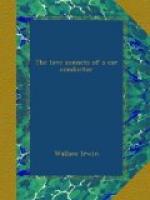The twenty-six exquisite Sonnets which form this Cycle were written, probably, during the years 1906 and 1907. Their author was William Henry Smith, a car conductor, who penned his passion, from time to time, on the back of transfer-slips which he treasured carefully in his hat[1]. We have it from no less an authority than Professor Sznuysko that the Car Conductor usually performed these literary feats in public, writing between fares on the rear platform of a Sixth Avenue car. Smith’s devotion to his Musa Sanctissima was often so hypnotic, I am told, that he neglected to let passengers on and off — nay, it is even held by some critics that he occasionally forgot to collect a fare. But be it said to his undying honor that his Employers never suffered from such carelessness, for it was the custom of our Poet to demand double fares from the old, the feeble and the mentally deficient.
Even as the illimitable ichor of star-dust, the mysterious Demiurge of the Universe, keeps the suns and planets to their orbitary revolutions, so must environment mark the Fas and Nefas of Genius. Plato’s Idea of the Archetypal Man was due, perhaps, as much to the serene weather conditions of Academe as to the marvelous mentality of Plato. What had Job eaten for breakfast that he should have given utterance to his magnificent Lamentation? Was he the discoverer of Human Sorrow or the pioneer of Human Dyspepsia?
It is not altogether radical on my part, then, for me to assert that many of the stylistic peculiarities found in these Sonnets are attributable to the locale of their inspiration the rear platform of a Sixth Avenue car. One can plainly hear the jar and jounce of the elliptical wheels, the cry, “Step lively!” the six o’clock stampede, the lament of the strap-hanging multitude in such lines as these:
“Three days with sad skidoo have came and went,
Yet Pansy cometh nix to ride with me.
I rubber vainly at the throng to see
Her golden locks — gee! such a discontent!
Perhaps she’s beat it with some soapy gent —
"
Where are lines like these to be found in the Italian of Petrarch? Where has Tasso uttered an impassioned confession to resemble this:
“But when I ogle Pansy in the throng
My heart turns over twice and rings a gong”?
Of the human or personal record of William Henry Smith very little has been discovered. Looking over the books of the Metropolitan Street Railway I unearthed the following entry:
“Nov. 1, 1907:”
“W. H. Smith, conductor, discharged.”
“Remarks: — Car No. 21144, William Smith, conductor, ran into large brewery truck at So. E. cor. Sixth Ave. It is reported that Smith, to the neglect of his duty, was reading poetry from a book called ’Sonnets of de Heredia’ at the time of the accident. Three Italians were slightly injured by the accident, and Ethelbert Pangwyn, an actor starring in ‘The Girl and the Idiot,’ a musical comedy, was killed.”




